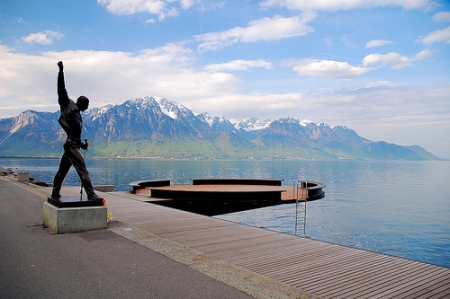 Founded in 1157, Fribourg was a sovereign republic until it joined the Swiss Confederation in 1481. Fribourg sits in a valley between lakes and mountains with the Saane river (Sarine in French) flowing through it. It is a gorgeous setting, but this is Switzerland, where picturesque settings abound. We’ve gotten accustomed to the incredible beauty and now almost expect it. Fribourg did not disappoint.
Founded in 1157, Fribourg was a sovereign republic until it joined the Swiss Confederation in 1481. Fribourg sits in a valley between lakes and mountains with the Saane river (Sarine in French) flowing through it. It is a gorgeous setting, but this is Switzerland, where picturesque settings abound. We’ve gotten accustomed to the incredible beauty and now almost expect it. Fribourg did not disappoint.
Fribourg isn’t large (population 40,000), but is charming. It is home to the University of Fribourg. This gives the city a slightly more cosmopolitan atmosphere and the vibrancy of a university town. It’s medieval neighborhoods are well-preserved and charming. The buildings show a blend of French and German Swiss culture.
Fribourg is known for its beautiful Gothic buildings. Its old patrician townhouses combine German baroque and French classicism. They have tons of detail, from stone carvings to ornate doors, to places to scrape your shoes. Architectural buffs and home decor enthusiasts will love them.
Wander the small, steep streets and medieval staircases. If you get tired, you can easily stop at a cafe in one of its many cobblestoned squares adorned with fountains. Fribourg also has a funicular for those less enthusiastic about urban hiking.
Walk across Fribourg’s beautiful bridges. The Pont de Berne, is a well-preserved covered wooden bridge dating from 1580. The solid, yet elegant, Central Bridge links the old town with opposing cliffs.
Crossing the river and climbing the hill on the opposite side yields stunning views of Fribourg’s Old Town. The St. Nicholas‘s Cathedral lofty 15th-century Gothic bell tower is also easily visible on the skyline.
The city hall’s (Hôtel de Ville) gothic clock tower dates from 1546 (the blue pointy thing). On Wednesdays, the square in front of city hall houses a market. The nearby Rue de Lausanne is a car-free pedestrian zone.
Fribourg is not just the name of the city. It is also the name of the canton (like the state). The canton of Fribourg is bilingual with the Saane river (Sarine in French) forming the language boundary. On one side, they speak French, on the other, Swiss German. All road signs in the Canton are bilingual!
Fribourg is the French speaking of the city. Freiburg is the German spelling, but is not commonly used to avoid confusion with the German town of Freiburg.
It is worth taking at least an afternoon to wander Fribourg’s streets. We plan on returning to spend an evening there.
Related articles
- Fondue In Switzerland = Cheesy, Gooey Goodness (schwingeninswitzerland.wordpress.com)







































































































